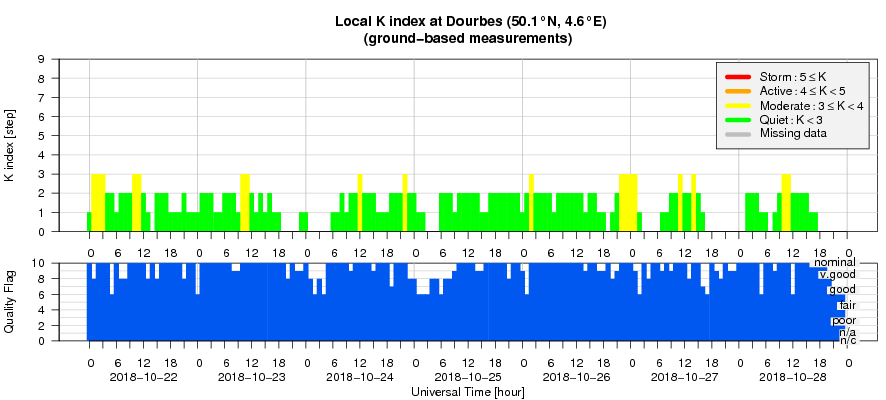- Table of Content
- 1.New records fo...
- 2.ESWW15 Live sp...
- 3.PROBA2 Observa...
- 4.Review of sola...
- 5.The SIDC space...
- 6.The Internatio...
- 7.Geomagnetic Ob...
- 8.Review of iono...
2. ESWW15 Live space weather forecast
3. PROBA2 Observations (22 Oct 2018 - 28 Oct 2018)
4. Review of solar and geomagnetic activity
5. The SIDC space weather Briefing
6. The International Sunspot Number
7. Geomagnetic Observations at Dourbes (22 Oct 2018 - 28 Oct 2018)
8. Review of ionospheric activity (22 Oct 2018 - 28 Oct 2018)
New records for the Parker Solar Probe
The Parker Solar Probe (PSP), a NASA mission to the outer solar atmosphere ("corona"), was launched on 12 August - see this news item at http://www.stce.be/news/435/welcome.html Following a Venus fly-by on 3 October, its trajectory has gradually brought it closer to the Sun, and the spacecraft is currently within the orbit of Mercury. On 29 October, day 78 of its mission, PSP's distance to our nearest star became less than 43.4 million km, breaking an old record set by the Helios 2 spacecraft on 17 April 1976. PSP's position (30 October) and the trajectory completed so far (green) can be seen in the map underneath (Credits: Johns Hopkins UAPL).
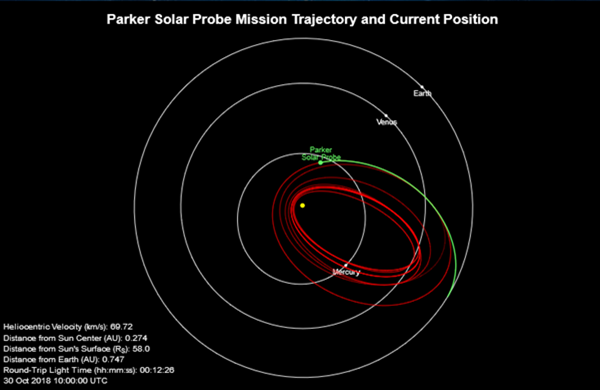
PSP is now on its way to its first rendez-vous with the Sun, planned for 6 November (already next week!). Its distance will then have further reduced, to about 24.8 million km. This is the first "dip" in the graph underneath and, as can be seen, subsequent close-encounters will bring it even closer to a distance of about 7 million km in 2024. As PSP is now also the fastest human-made object, it will continue to set new speed records, reaching 95 km/s on 6 November, and 192 km/s in 2024. The first science results of next week's encounter are expected in December this year.
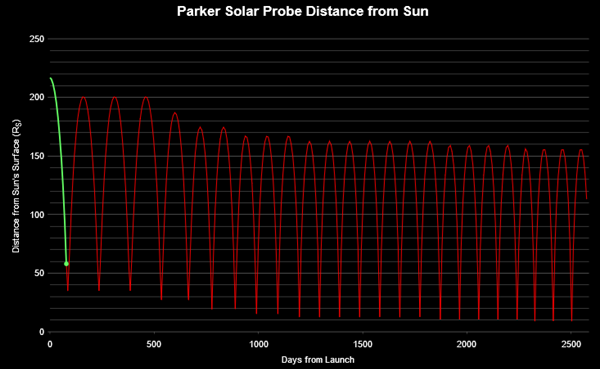
More information and the latest news at the dedicated PSP website http://parkersolarprobe.jhuapl.edu/ , hosted by the Johns Hopkins University Applied Physics Laboratory.
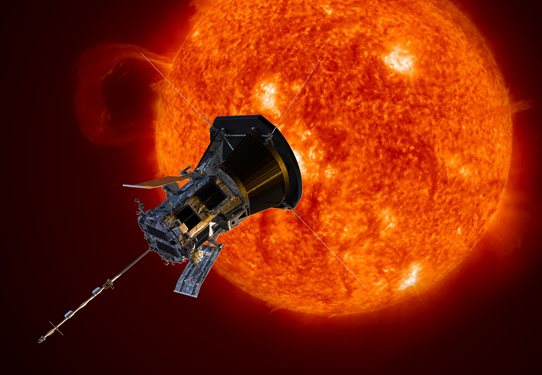
ESWW15 Live space weather forecast
Dear ESWW15 participant
Those of you who regularly attend European Space Weather Week will I hope remember the daily Live Space Weather Forecasts that we have initiated to help us think about the real world impact of Space Weather and how we as a community can improve our communication of these complex issues to the wider public.
We sent out a 'call for Live space weather forecast' and this resulted in:
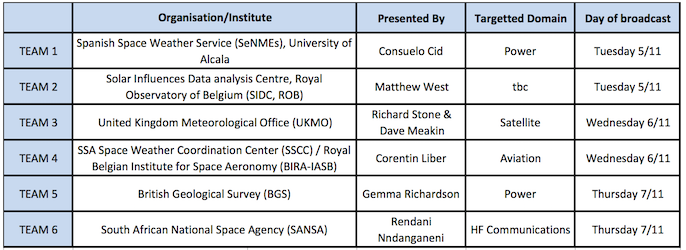
We look forwards to meeting you at ESWW15 and enjoying your forecasts!!
Ellen, Dave, Petra, on behalf of the PC
PROBA2 Observations (22 Oct 2018 - 28 Oct 2018)
Solar Activity
Solar flare activity remained very low during the week.
In order to view the activity of this week in more detail, we suggest to go to the following website from which all the daily (normal and difference) movies can be accessed: http://proba2.oma.be/ssa
This page also lists the recorded flaring events.
A weekly overview movie can be found here (SWAP week 448): http://proba2.oma.be/swap/data/mpg/movies/weekly_movies/weekly_movie_2018_10_22.mp4
Details about some of this week's events, can be found further below.
If any of the linked movies are unavailable they can be found in the P2SC movie repository here: http://proba2.oma.be/swap/data/mpg/movies/
Thursday Oct 25
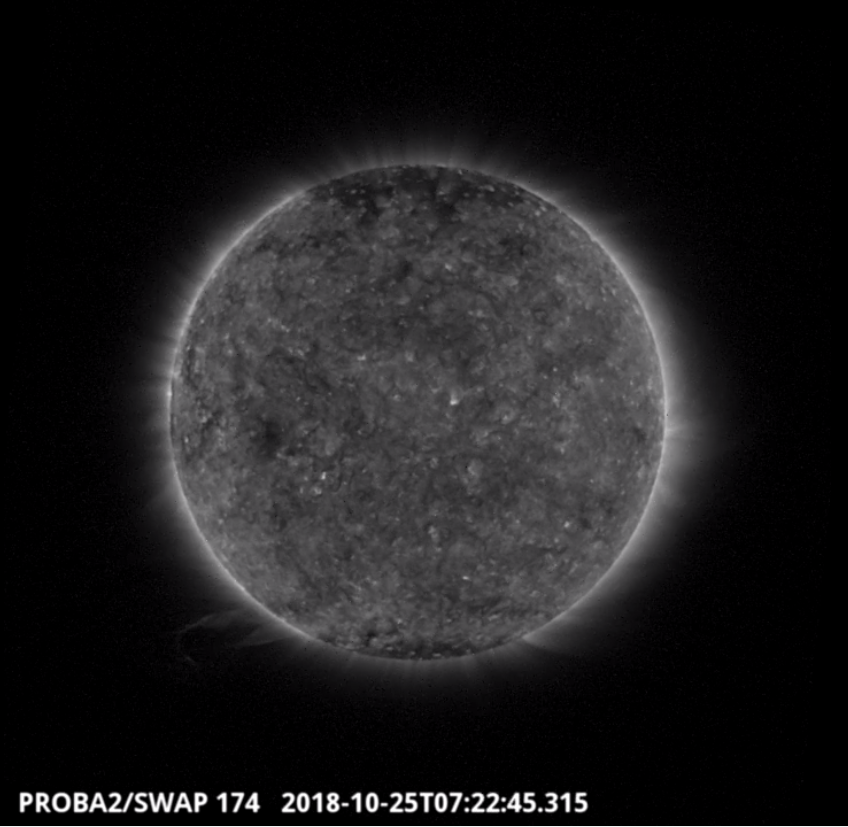
An eruption was observed by SWAP on 2018-Oct-25 on the south-east limb of the Sun, as shown in the SWAP image above taken at 07:22 UT.
Find a movie of the event here (SWAP movie): http://proba2.oma.be/swap/data/mpg/movies/20181025_swap_movie.mp4
Review of solar and geomagnetic activity
SOLAR ACTIVITY
Over the past week hours solar activity has been low. No significant flares have been recorded.
There have been no significant Active Regions on the solar disk. There were no flares recorded.
No Earth directed Coronal Mass Ejections (CMEs) have been detected.
The greater than 10MeV proton flux remained at background levels.
GEOMAGNETIC ACTIVITY
The solar wind speed has fluctuated between 320 and 420 km/s over the past week. The total magnetic field strength has fluctuated between 5 nT and 10 nT, but mainly fluctuated around 5 nT. The Bz component fluctuated around 0 nT, ranging between -10 and +10 nT and briefly at the beginning of the week. The enhanced Bz and solar wind speed were due to a HSS from a small coronal hole at the beginning of the week.
Geomagnetic conditions ranged between Kp index 0-3 (NOAA) and local K index 0-3 (Dourbes) throughout the week. Geomagnetic conditions were quiet. Next week Geomagnetic conditions are expected to be quiet.
The SIDC space weather Briefing
The Space Weather Briefing presented by the forecaster on duty from October 22 to 28. It reflects in images and graphs what is written in the Solar and Geomagnetic Activity report.
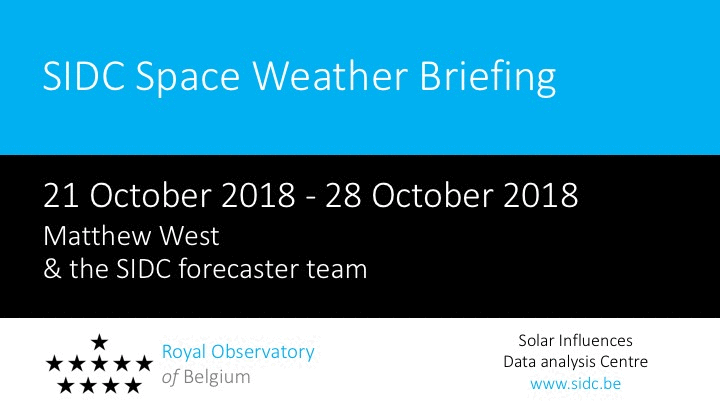
The pdf-version: http://www.stce.be/briefings/20181029_SWbriefing.pdf
An automatically running presentation: http://www.stce.be/briefings/20181029_SWbriefing.ppsm
The International Sunspot Number
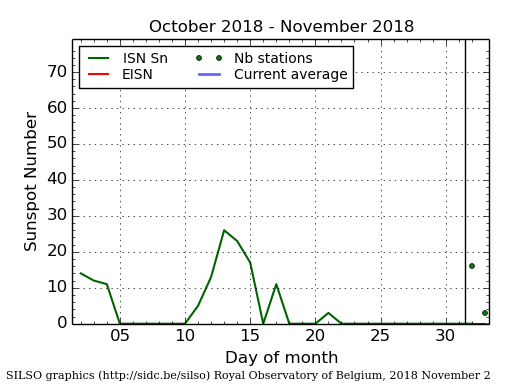
The daily Estimated International Sunspot Number (EISN, red curve with shaded error) derived by a simplified method from real-time data from the worldwide SILSO network. It extends the official Sunspot Number from the full processing of the preceding month (green line). The plot shows the last 30 days (about one solar rotation). The horizontal blue line shows the current monthly average, while the green dots give the number of stations included in the calculation of the EISN for each day.
Review of ionospheric activity (22 Oct 2018 - 28 Oct 2018)
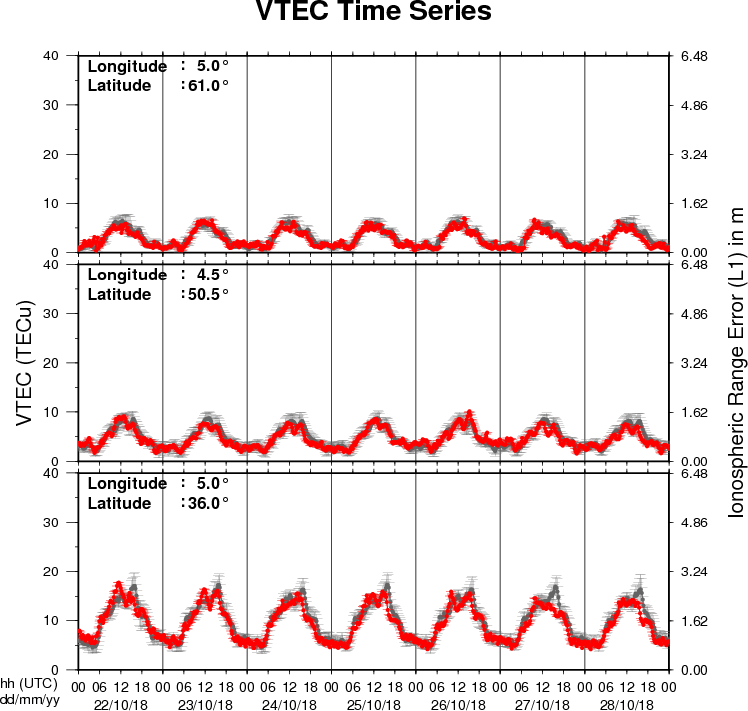
The figure shows the time evolution of the Vertical Total Electron Content (VTEC) (in red) during the last week at three locations:
a) in the northern part of Europe(N61°, 5°E)
b) above Brussels(N50.5°, 4.5°E)
c) in the southern part of Europe(N36°, 5°E)
This figure also shows (in grey) the normal ionospheric behaviour expected based on the median VTEC from the 15 previous days.
The VTEC is expressed in TECu (with TECu=10^16 electrons per square meter) and is directly related to the signal propagation delay due to the ionosphere (in figure: delay on GPS L1 frequency).
The Sun's radiation ionizes the Earth's upper atmosphere, the ionosphere, located from about 60km to 1000km above the Earth's surface.The ionization process in the ionosphere produces ions and free electrons. These electrons perturb the propagation of the GNSS (Global Navigation Satellite System) signals by inducing a so-called ionospheric delay.
See http://stce.be/newsletter/GNSS_final.pdf for some more explanations ; for detailed information, see http://gnss.be/ionosphere_tutorial.php
